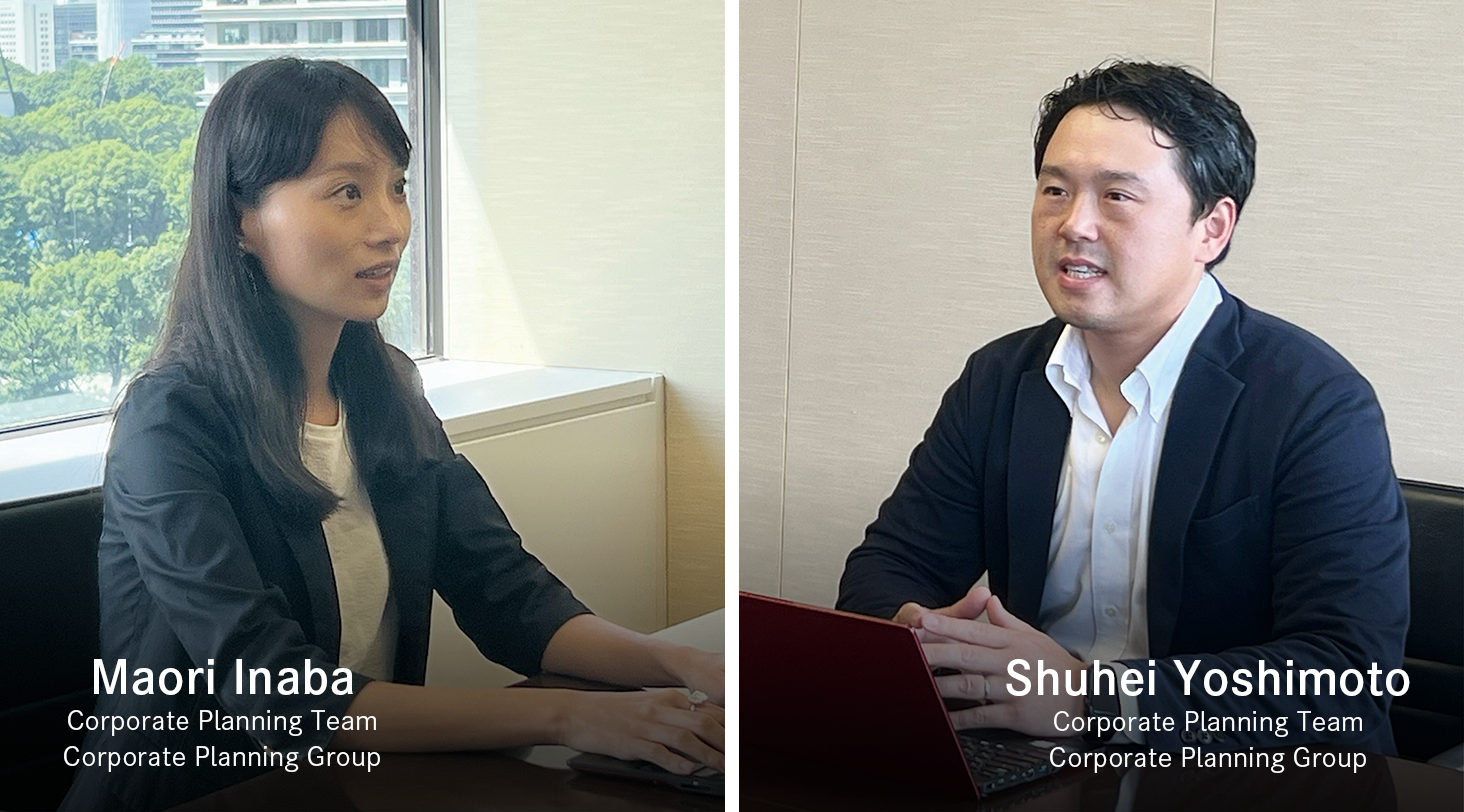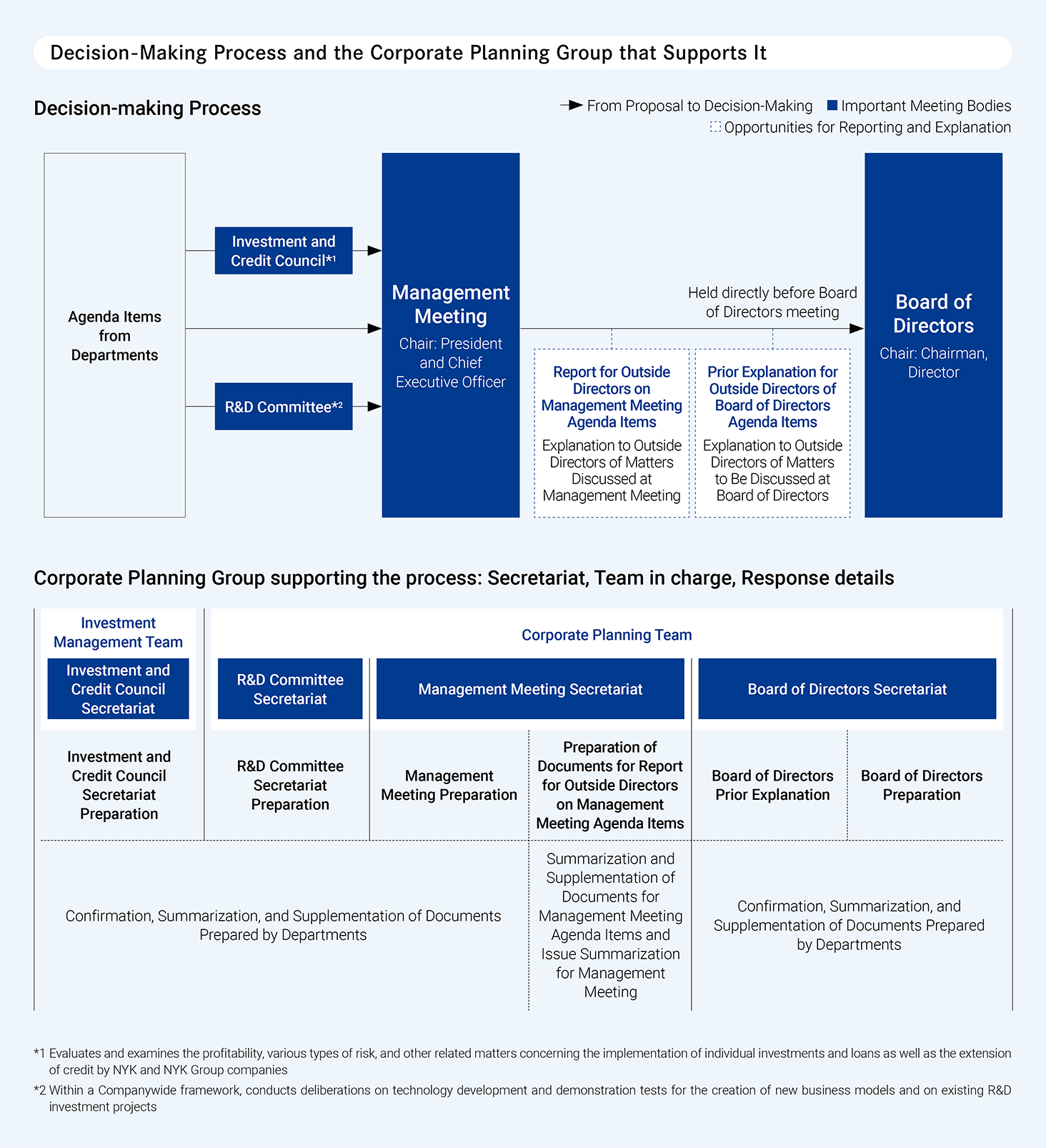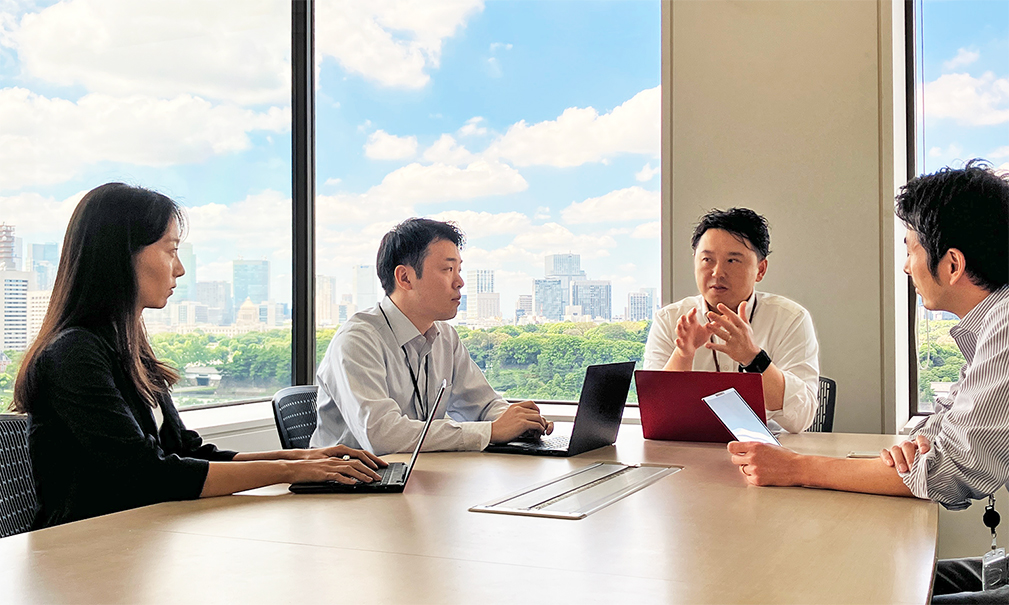Toward a More Flexible and Transparent Decision-Making Process
In 2020, NYK embarked on a major transformation of its governance structure with the aim of establishing a more flexible and transparent decision-making process. At the time, proposals were submitted to the Board of Directors after the approval of or the reporting to the Committee of Corporate Officers. This committee was a decision-making body in which all 28 members—including the president, chairman, and corporate officers, including those serving concurrently as directors—participated in making decisions on proposals submitted by departments. Decision-making took time, and approval required agreement by a majority of the committee members.
To establish a more flexible and transparent decision-making process, the authority previously held by the management committee was transferred to the president and chief executive officer to ensure agility in decision-making. Furthermore, to ensure high transparency, the Management Meeting was established as a pre-deliberation forum.
This meeting comprises the chairman, president, chief executives, and deputy chief executives who are all executive officers. As it has fewer members than its predecessor, the meeting enables the prompt, efficient sharing of information. In addition, at the Management Meeting, the chief executives of all headquarters make statements for or against agenda items including the reasons, and the president himself makes the final decision based on the opinions of the chief executives.
Through these changes, NYK’s decision-making process has evolved to become more flexible and highly transparent.

Providing Behind-the-Scenes Support for Management Decision-Making
A more transparent and flexible decision-making mechanism has been established, but the preparation and coordination of each meeting body have become more important to ensure the process runs smoothly. In particular, since the president assumes full responsibility at the Management Meeting, more support than before is needed to ensure that the president makes appropriate decisions. In addition, information from each department must be organized and compiled into readily understandable documents so that the president, chief executives, and other members can use their limited time effectively and have productive discussions. These tasks are coordinated by the Corporate Planning Team, which belongs to the Corporate Planning Group. A member of the team, Shuhei Yoshimoto, explains its function as follows.
“Our role is to carefully examine the information used by senior management when making decisions. Each Management Meeting and Board of Directors’ meeting takes two to three hours. Respective matters have deadlines by which determinations must be finalized, but the number of matters that each meeting can handle is finite. While fretting over the timing of the submissions of the multiple matters requiring deliberation and switching their order, we work with each department to make detailed preparations so that the necessary decision-making is conducted within the limited time available.”
Yoshimoto goes on to describe the team’s specific duties.
“Our basic job is to prepare documents for discussions at meetings. We read the documents prepared by departments and check them against Company rules and the minutes and requests for approval at previous meetings. If unidentified risks or important omissions are noticed, we repeatedly communicate with the relevant business departments to address each issue and improve the documents.”
To facilitate the discussions of the senior management the team serves as a watchdog, so to speak. Maori Inaba says that this is why the team is probably seen by other departments as being troublesome. While revealing the difficulty of reaching an in-house consensus, she emphasizes the responsibilities of her job.
“To prepare documents that management can understand at once, we are very eager to resolve each question identified. However, the departments may see frequent communication as a burden. Although I sometimes feel sorry for them, I make the necessary checks based on the belief that we are performing important duties that support decision-making in the NYK Group.”
The Corporate Planning Team is responsible for a wide range of important bodies, from the Management Meeting (including reports on matters discussed by the Management Meeting for outside directors) through to the Board of Directors’ meetings (including prior briefings on matters to be discussed by the Board of Directors for outside directors). The team engages in the preparations for each body on a weekly basis. Team members serve as a filter and provide appropriate assistance to senior management.

Enhancing Understanding through Multiple Viewpoints Both Inside and Outside the Company
Yoshimoto explains that reflecting multiple viewpoints is important in supporting appropriate decision-making by senior management.
“Based on the recognition that our job is to support management in making the right business decisions, our goal is to consider the key points requiring decisions by the president and prepare documents highlighting these points. Therefore, we prepare documents from the viewpoint of how we would approach matters if we were president. This viewpoint is adopted by all members of the secretariats of meetings, and multiple members check documents. We also fill in any omissions and enhance the materials by having documents checked by departments across the organization. For example, checks are conducted by the Finance Group, the Accounting Group, the Legal & Fair Trade Promotion Group, the ESG Management Group, and the Decarbonization Group.”
He continues explaining the team’s approach.
“We are involved in a wide range of bodies. For this reason, only reflecting the president’s point of view is not enough. For instance, with respect to the Board of Directors’ meetings, we must organize information in a way that reflects the viewpoint of outside directors. These directors are not originally from the Company. Their knowledge of the maritime shipping industry’s unique characteristics and historical background differs from that of inside directors. That is why, while incorporating information necessary for outside directors in the various documents, we focus on paring down the information to content necessary for decision-making. We try to condense the information into concise, easy-to-understand formats.”
It takes time to acquire the ability to align your viewpoint with those of the various senior management members who view the documents. Yoshimoto says that since joining the Corporate Planning Team, he has developed the habit of repeatedly asking himself questions.
“The effectiveness of the Board of Directors is evaluated annually. If comments indicate that the documents include too much information, we improve their quality by finding ways of making them less detailed. We also make adjustments by checking the minutes of each meeting and augmenting information in the areas on which questions are focused.”
The team uses minutes and feedback to identify areas for improvement and enhances documents accordingly. While constantly asking themselves whether they are providing useful information, team members obtain multiple, precise viewpoints. These systematic efforts heighten the sophistication of NYK’s decision-making process.
Internalizing the Decision-Making Process
Yoshimoto and Inaba both say that when they see a project taking shape and being announced externally through press releases, they feel as happy as if the achievements were their own. Inaba describes the team’s attitude to its work.
“Our mindset when interacting with other departments as we check and prepare documents is that we are responsible for each project ourselves. Although the checking process conducted with departments is painstaking, the steady efforts of the person in charge are connected to the larger flow of management. I feel that it would be good if such things could be conveyed to the person in charge through communication with each department.”
Yoshimoto sums up his motivation.
“During hectic days, I occasionally feel that I am not rewarded. Nonetheless, when the president or another member of management remarks that a document was easy to understand, I feel glad that we made the effort to prepare a good document. We work as a team, striving to become the right-hand support for management through trial and error, and I take pride in contributing to decision-making at NYK. ”
Four years have passed since the reform of NYK’s governance structure. Yoshimoto is confident that the new decision-making process is ensuring flexibility and transparency. He emphasizes his expectations and vision for the future.
“Going forward, I believe that senior management must share in-house their thinking and how decisions are being made. The sharing of the leadership’s thinking will convey management policy to employees. If all employees can reflect management’s viewpoint in each project, the decision-making process will evolve even further.”
If the entire Company can share the same viewpoint, the decision-making process of NYK, and by extension its governance, will become evermore advanced. While continuing to reflect multiple viewpoints and thereby support senior management’s decision-making, the Corporate Planning Team will endeavor to share management thinking Companywide.
(Interview July 19, 2024)





